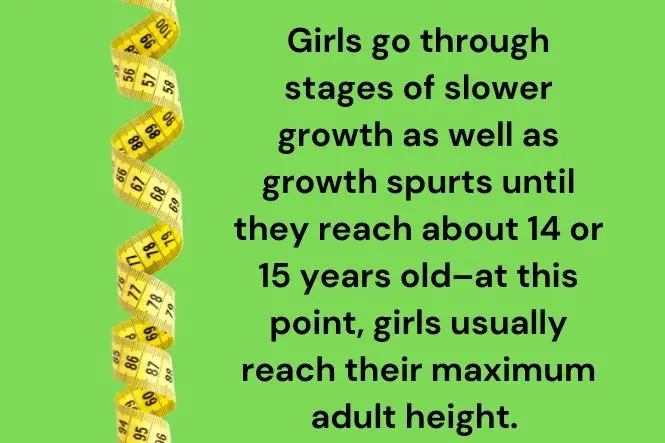Girls go through stages of slower growth as well as growth spurts until they reach about 14 or 15 years old–at this point, girls usually reach their maximum adult height. Another way of estimating the age at which a girl will stop growing is to add two years to the age at which she began menstruating–though this method is less accurate for girls who started their period before the age of 11. Many factors affect the age at which a girl stops growing and puberty is just one of them.
While a girl’s height typically reaches a set point during her teenage years, other aspects of growth such as weight and breast development are not quite as defined or predictable. Weight can change throughout a girl’s life due to factors such as activity level, food intake, stress, hormonal changes including menopause, pregnancy, and medical issues. Breasts also change throughout puberty as well as adulthood for the same reasons that weight does.
The growth rate, height, and weight of a girl can all be impacted by things like genetics and family history–these factors play a big role in a girl’s growth and development. Nutrition and physical activity will also influence how a girl develops throughout childhood and adolescence. Lastly, there are medical conditions as well as medications that can sometimes delay the rate of growth or stunt a girl’s growth.

How Is Growth Affected By Puberty?
There are two time periods in a girl’s life when they do the majority of their growing: the first is during early childhood, in the first few years after birth; the second is during puberty. A girl’s body can change quite a lot during puberty–not just her height, but also weight, breast development, and the appearance of body hair. Puberty is also the time at which a girl will begin menstruating.
Overall, girls enter puberty at an earlier age than boys do–this can range from as early as 8 years old to as late as age 14. The average age at which girls begin puberty is around 11 years old. Body fat has an impact on when girls will start puberty, since they will not start menstruating if they do not have a high enough body fat percentage. Thus, girls who are involved in activities like gymnastics or ballet that usually require a low weight, are likely to start puberty later, while girls who are overweight may start earlier.
When it comes to height, many girls will have a growth spurt a year or two before they begin menstruating. After their period starts, girls can add anywhere from one to four inches to their height, though the average growth for a girl after menstruation starts is 2.5 inches in height. For example, if a girl is 5 feet tall when she starts her period, her adult height is estimated to be between 5 foot 1 inch and 5 foot 4 inches.
What Is The Average Height For Girls?
Using the growth charts published by the Centers for Disease Control and Prevention (CDC), we can determine the average height for girls at various ages. The average height for girls tends to increase the most as they are entering their teenage years. At the age of 12, most girls are around 4 foot 11.5 inches tall but by 13 years old they are averaging 5 foot 2 inches–an increase of 2.5 inches in only a year.
By the age of 14, height increases an additional inch, with the median height for girls reaching 5 foot 3 inches. By 16 years old, the median height goes up another inch to 5 foot 4 inches. The vast majority of girls have reached their maximum height by the age of 16 and it is unlikely that they will grow taller past this age.
Looking at the growth chart for women who are 20 years old, we can see that the median has only increased slightly to around 5 foot 4.25 inches. Only five percent of women this age are taller than 5 foot 8.5 inches. About 95 percent of women who are 20 years old are taller than 5 feet.
What Is The Average Weight For Girls?
Weight can vary quite a bit for girls depending on several factors such as diet, activity level, genetics, and medical conditions. The CDC growth charts provide an overview of the median body weight for girls up to the age of 20. Girls’ weight tends to change the most rapidly during childhood and tapers off as they reach the teenage years.
At the age of 13, the median weight for girls is about 102 pounds. Only five percent of girls this age weigh less than 76 pounds and five percent weigh over 148 pounds. By age 15, the median weight for girls goes up to about 114 pounds, with five percent weighing under 89 pounds and five percent above 166 pounds.
By the time a girl reaches the age of 17, the median weight is around 121 pounds, with five percent weighing less than 98 pounds and five percent weighing more than 175 pounds. At the age of 20, the median has increased to 128 pounds. Fewer than five percent of 20-year-old women weigh under 102 pounds, while around five percent weigh more than 182.
Do Genetics Impact A Girl’s Growth?
Genetics play a major role in the growth and development of girls, including height, weight, breast development, and other areas of growth. A girl’s height is largely determined by genetic factors and you can generally get a rough estimate using a simple calculation. Add the two parents’ heights together, subtract five inches, and divide by 2. For example, if the first parent is 6 feet and the second parent is 5 foot 5 inches, the calculation would be (72+65-5)/2=66 inches or 5 foot 6 inches.
Weight is also influenced by genetic factors, though not as much as height. Girls who are overweight are more likely to have overweight parents, however, this is not always due to genetics but can involve lifestyle factors that they share such as food intake and activity level. Certain medical conditions that are genetic can also influence a girl’s weight.
Prader-Willi syndrome is a genetic condition that causes extreme appetite that is not satisfied by eating. Without strict supervision and limitations on food during childhood, these children typically become obese. Prader-Willi syndrome is the most common genetic cause of obesity in children and affects about 1 in 20,000 people.
What Can Delay Growth?
There are several factors that can impede growth during childhood and adolescence including illnesses, medical conditions, some medications, and malnutrition. Diseases such as cystic fibrosis and celiac disease can slow down a girl’s growth rate, contributing to a shorter stature and lower weight. Low growth hormone and low thyroid can also delay growth.
Turner syndrome, which affects only females, can cause girls to have short stature, smaller fingers and toes, delayed puberty, and even infertility. In terms of medications that can delay growth, some studies have found that certain ADHD medications are associated with a slower growth rate, likely because many ADHD medications are stimulants that suppress the appetite. Corticosteroids, such as those used for the treatment of asthma, can also reduce the rate of growth.
Malnutrition is another cause of delayed growth–girls who do not eat an adequate amount of food or absorb enough nutrients are likely to see a slower rate of growth. Eating disorders are common among girls, particularly in the adolescent years–these disorders can cause significant harm and should be addressed by a healthcare provider as soon as possible. If a girl has not developed breast buds by age 13 or hasn’t started her period by age 16, these are signs of delayed growth.
How Does Nutrition Affect Growth?
Nutrition plays a fundamental role in all areas of a girl’s growth including their height, weight, and other aspects of development. From birth through to adulthood, proper nutrition is one of the keys to good health, and attention should be paid to food intake to ensure a balanced diet. Growth is much more likely to progress along a healthy path if girls are getting adequate amounts of macronutrients, vitamins, and minerals.
Carbohydrates are important because they provide the energy needed for growth–healthy carbohydrates include whole grains, vegetables, fruits, and legumes. Protein is also vital for proper growth because it helps to build and repair muscles–this macronutrient can be found in meat, poultry, fish, dairy products, and legumes. Fats also play a role in growth rate; healthy fats help not only the body to grow but also the brain, while unhealthy fats can lead to heart disease and obesity.
Minerals such as magnesium, potassium, phosphorus, zinc, and iron all contribute to healthy growth as well. Calcium intake is important as it helps build strong bones; it also helps the muscles to function properly. Vitamins provide essential nutrients to the body, for example, B vitamins help the body use the energy from carbohydrates and fats.
When Do Girls’ Breasts Stop Growing?
While girls’ height generally reaches its maximum by age 14 or 15, and weight can fluctuate throughout a person’s life, breast growth falls somewhere in the middle. For the majority of girls, breast development is the first sign of puberty. Girls will notice small bumps begin to appear, usually between 9 and 11 years old–it is normal if one breast develops before the other.
Most girls will experience the beginnings of breast growth about 2 or 2.5 years before they start menstruating, though this can range from 1 to 4 years. Breast will usually continue to grow until 1 to 2 years after menstruation starts, though some girls experience growth up until age 18. Breast growth is somewhat influenced by genetics, but weight can have a significant impact as well.
While breast growth is generally completed in the teenage years, they will continue to change shape over time. As females gain or lose weight, the shape of their breasts can change. Pregnancy and breastfeeding can also create noticeable changes in breast size and shape.
Do Girls Grow Faster Than Boys?
During adolescence, it may seem as though girls are growing at a faster rate than boys. However, girls simply start growing earlier than boys, so they are often taller and more developed than boys of the same age. Girls tend to have growth spurts earlier than boys and enter puberty at a younger age as well.
Growth spurts in girls often occur around age 9 or 10, while boys are usually 12 or 13 when they have a major growth spurt. The average age of puberty onset for girls is age 11, whereas for boys it is age 12. When it comes to body mass, both girls and boys tend to gain weight during puberty but girls generally see the addition of fat while boys add muscle.
It is interesting to note that it is not just physical growth, but brain growth as well that differs between girls and boys. Just as girls enter puberty earlier, they also experience brain development in certain areas earlier as well. Some types of cognitive and emotional processes mature faster in girls, around age 10 to 12, than they do in boys who experience bigger changes in brain development after age 15.
Final Thoughts
As you can see, there is a combination of multiple factors that contribute to the growth of girls and impact when they stop growing. Growth is significantly affected by puberty for girls who can expect to see major changes in height, weight, and breast development during this time. While genetics and medical conditions play a role in determining growth, it is important to remember that exercise, nutrition, adequate sleep, and low levels of stress are also impactful. Many of the lifestyle habits that girls have during their teen years will persist throughout adulthood, so encouraging girls to develop healthy habits while they are young can have lifelong benefits.







